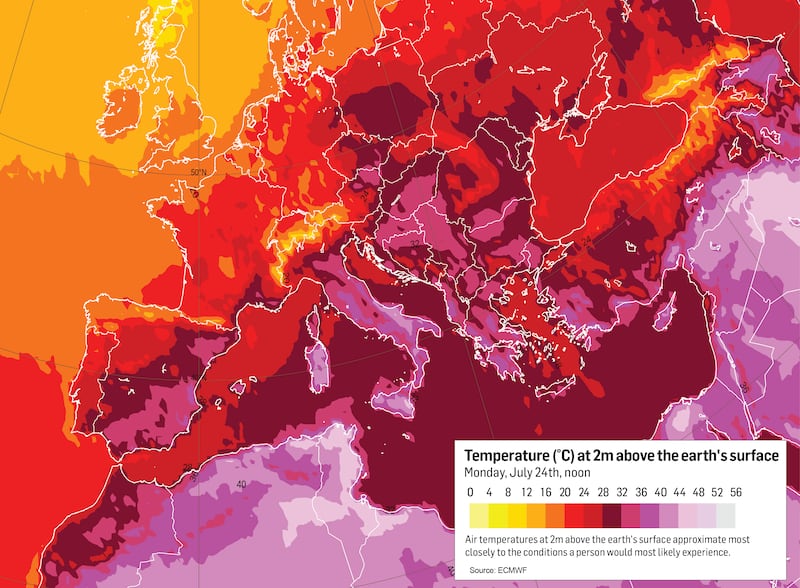The searing heatwaves impacting Europe and North America would have been almost impossible without climate change, rapid attribution analysis by scientists shows.
Heatwaves with record temperatures are no longer rare due to warming caused by burning fossil fuels and other human activities and confirm that the planet is not warming evenly, research by World Weather Attribution (WWA), which evaluates extreme weather events, shows.
“Events like these can now be expected approximately once every 15 years in North America, about once every 10 years in southern Europe and approximately once every five years in China,” they conclude in a study published on Tuesday.
Future heatwaves across the northern hemisphere will be hotter, longer and more common if carbon emissions are not rapidly cut, WWA scientists warn.
RM Block
This month southern Europe, parts of the US, Mexico and China have experienced severe heatwaves with temperatures routinely above 45 degrees, leading to wildfires and heat-related hospital admissions and deaths. The study also found climate change made the heatwave in China “at least 50 times more likely”.
Heatwaves in the US and China are classed as “heat domes”, while the one over Europe is more of a sub-Saharan “heat blast”. In both instances there is a locked-in pattern that is persisting due to the Jet Stream’s location in the upper atmosphere.
To quantify the effect of climate change on the recent sustained high temperatures, WWA scientists, who are part of an international collaboration, analysed weather data and computer model simulations. They compared the climate as it is today – after about 1.2 degrees of global warming since the late 1800s – with the climate of the past, following robust, proven methods.
[ Ireland’s pace of climate policy implementation ‘not acceptable’, says watchdog ]

The analysis focused on periods when the heat was most dangerous in each region: average maximum temperatures over seven days in southern Europe, over 18 days in the western US, Texas and northern Mexico, and over 14 days in lowlands of China, where an unprecedented 52.2 degrees was recorded recently.
The European and North American temperatures would have been “virtually impossible without the effects of burning coal, oil and gas, deforestation and other human activities”.
Greenhouse gas emissions made the heatwaves hotter: the European heatwave was 2.5 degrees hotter; the North American heatwave was 2 degrees hotter; and the heatwave in China was 1 degree hotter because of climate change.
Heatwaves like these will become more frequent and extreme if emissions are not rapidly halted and reduced to net zero, the scientists warn. If temperature rise reaches 2 degrees – as will happen in about 30 years unless every country signed up to the Paris Agreement fully implements their pledges to rapidly cut emissions – events like this will become even more frequent, occurring every two to five years.
While the researchers say the development of El Niño, a naturally occurring climate phenomenon, likely contributed some additional heat in some regions, increased global temperatures from burning fossil fuels is the main reason the heatwaves are so severe.
The study was conducted by seven researchers as part of the WWA group, including scientists from universities and meteorological agencies in the Netherlands, the UK and the US.
“The result of this attribution study is not surprising,” said Friederike Otto, Imperial College London climatologist. “The world hasn’t stopped burning fossil fuels, the climate continues to warm and heatwaves continue to become more extreme. It is that simple.”
She said: “However, these heatwaves are not evidence of ‘runaway warming’ or ‘climate collapse’. We still have time to secure a safe and healthy future but we urgently need to stop burning fossil fuels and invest in decreasing vulnerability. If we do not, tens of thousands of people will keep dying from heat-related causes each year.”
Dr Otto said it was “absolutely critical” that governments legislate for a fossil fuel phase out at this year’s COP28 climate conference in UAE.
Sjoukje Philip, of the Netherlands Meteorological Institute, said with the Earth warming unevenly climate scientists were working to understand the complex relationships between increasing global and regional average temperatures.
“Once again, our study shows the significant impact of the rapid rate of warming on local temperatures in Europe. It underscores the urgent necessity for Europe to continuously take adaptation and mitigation measures,” she said.


















